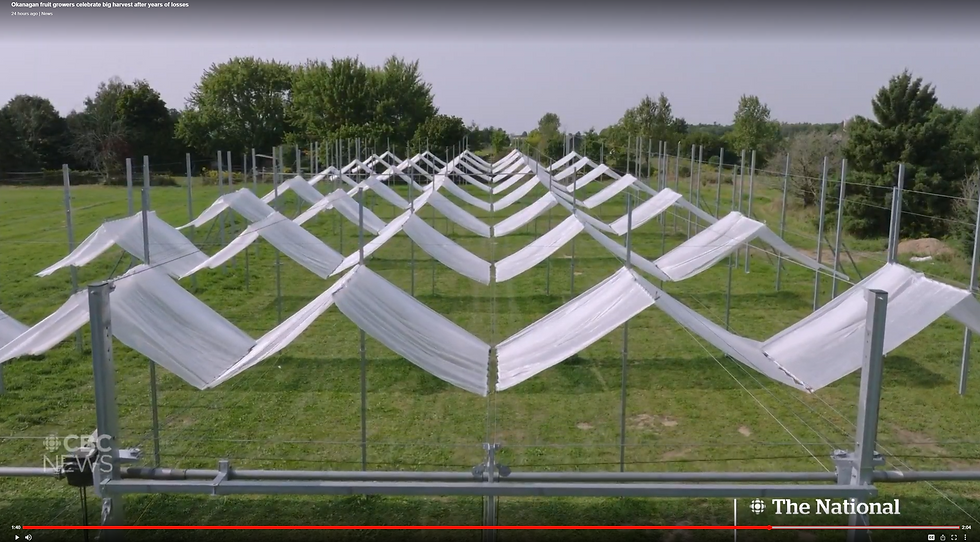61% increase in raspberry yields and 3 strawberry production systems
- Cravo News

- Feb 8, 2023
- 4 min read
Retractable Cooling house produced 61% more raspberries per hectare with a 75% reduction in agrichemicals and 3 strawberry production systems with 83,000 to 166,000 plants per hectare

At Cravo, we are always trying to develop new ways for growers to increase their profitability by optimizing their growing environment by combining the advantages of the natural outdoors and a protected environment. Last year we outfitted our demonstration center in Irapuato Mexico to produce hydroponic raspberries and strawberries.

Cravo Demonstration and Training house at Irapuato Mexico.
Irapuato is at 1,700m elevation and latitude 20N. The high elevation causes sun radiation to be high year round with occasional cloudy periods lasting only several hours during rainfall. The summer temperatures fluctuate from 20C to 40C with RH of 10%-50%. Heavy rains occur from July to September. Winter temperatures fluctuate from 0C- 31C.
Strawberries
This year, our focus was to evaluate different set ups in the retractable Flat Roof Cooling house for the hydroponic gutters which would affect plant density and the efficiency of spraying.
1. 3 different production systems inside the retractable Flat Roof cooling house
a. 5 sets of double gutters with a roadway for mechanical spraying
b. 10 single gutters
c. NGS rotating gutter system
2. Summary of key learnings so far:
a. Timing:
The cooling roof allows for young plants to be transplanted during the heat in July to target the high price October to December window.
First harvests can occur in October provided nighttime temperatures are low enough to induce flowering.
The cooling roof helps extend the harvest into May or June.
b. Density:
The 5 rows of double gutters created a density of 83,333 plants/ hectare and allows for mechanical spraying.
The 10 rows of single gutters created a density of 83,333 plants/ hectare but requires manual spraying with a backpack.
The NGS rotating gutter system creates the highest plant density of 166,000 plants/ hectare but requires manual spraying with a backpack.
Higher densities in the retractable roof does not appear to negatively affect yield per plant since retracting the roof dramatically increases light levels and rapidly lowers humidity levels.
c. Rain in a flat roof:
There was no major negative impact growing in the flat roof considering that rain passes through the roof covering. The heavy rainfall typically occurs in the summer when the plants are growing vegetatively, and the plastic grow bags limit the amount of water that reaches the substrate. The ability to retract the roof after a rain allows plants to dry off rapidly.
Video overview of the 3 strawberry production systems
Raspberries
We transplanted tips on April 8 in order to create the optimum control strategies for the roof and mist through the hot and dry summer conditions. We then did a second transplanting of tips on June 10 to target the harvest during the high price winter season. Results of this second planting will be released at a later date.
For our raspberry trials, we were privileged to work with Giddings, Black Venture and Berryworld varieties.
Objectives:
1. Determine optimum control strategies for the retractable cooling roof and misting system during the summer and winter.
2. Increase the total yield and the % of #1 quality fruit.
3. Reduce the use of agrichemicals and total # of spray applications per month.
4. Hit the high price winter season using tips which have a lower cost of production than long cane.
Key learnings to date
1. Control strategies
a. Cooling roof retracted when leaf temperature exceeded 16C and closed 95% when leaf temperature exceeded 26C.
b. The misting system activated to maintain a minimum of 40% RH.
2. Impact on yields and fruit quality
a. Results in retractable roof to local commercial growers using conventional tunnels for Diamond Jubilee tips transplanted April 8, 2022 with August to October harvest:
Plants per hectare in the retractable roof increased 22% from 13,000 to 15,873.
#1 quality fruit per plant for the primocanes increased 32% in retractable roof from 621 to 821 grams per plant.
Yield per hectare for the primocanes increased 61% from 8,073 to 13,032 kg.
Poor pollination in the flat roof caused a reduction in #1 quality due to the extensive rains during the flowering period causing pollen to be wet and bees to be inactive. Pollination was 100% during the winter season when there was minimal rain.

3. Incidence of disease and insects
a. 91% average reduction in foliar disease
b. 76% average reduction in insect pressure

4. Impact on agrichemicals, organic sprays and number of spray applications per month
a. 75% reduction in agrichemical usage
b. 50% increase in organic sprays
c. 50% reduction in the total number of spray applications

Growing Diamond Jubilee, Malu and Alexa raspberries hydroponically in a retractable cooling house
Update on Diamond Jubilee raspberries in retractable flat roof at Irapuato Mexico, Dec 9, 2022



